Metal pergolas – they’re not just for climbing vines anymore! These sturdy structures are becoming the go-to choice for creating stunning outdoor spaces that are both functional and fabulous. Imagine sipping your morning coffee under a sleek, modern pergola, or hosting a dinner party beneath a romantic, wrought iron masterpiece. The possibilities are endless, and with a little creativity, you can transform your backyard into an outdoor oasis that’s the envy of the neighborhood.
But before you start sketching your dream pergola, there’s a lot to consider. From choosing the right metal to planning your design, we’ll dive into the world of metal pergolas, exploring everything from the basics to the latest trends. So grab a comfy chair, a refreshing drink, and let’s get started!
Introduction to Metal Pergolas
A metal pergola is a freestanding structure that typically consists of a framework made of metal, such as aluminum, steel, or wrought iron, with a latticework top that provides shade and support for climbing plants. It serves as a decorative and functional element in outdoor spaces, adding visual interest and providing shade from the sun.
Choosing a metal pergola offers several advantages over other materials like wood or vinyl. Metal pergolas are durable and resistant to weather elements, making them a long-lasting investment. They are also generally low maintenance, requiring minimal upkeep compared to wooden structures.
Metal Pergola Designs
Metal pergolas are available in a wide variety of designs to suit different styles and preferences. Here are some examples:
- Modern Pergolas: These designs often feature clean lines, minimalist aesthetics, and geometric shapes. They may be made from powder-coated aluminum or stainless steel, with sleek and contemporary finishes.
- Traditional Pergolas: Inspired by classic architecture, these pergolas feature ornate details, intricate latticework, and decorative elements. They are often made from wrought iron or steel with a rustic or antique finish.
- Rustic Pergolas: These designs embrace a natural and earthy aesthetic. They may be made from weathered steel or reclaimed metal, with a rough and unfinished look.
Types of Metal Used in Pergolas
Metal pergolas offer a range of benefits, including durability, low maintenance, and a modern aesthetic. The choice of metal can significantly impact the pergola’s longevity, upkeep, and overall appearance.
Aluminum
Aluminum is a popular choice for pergolas due to its lightweight, corrosion-resistant properties. It is also relatively inexpensive compared to other metals.
- Aluminum is lightweight, making it easier to transport and install.
- Aluminum is highly resistant to rust and corrosion, making it ideal for outdoor use.
- Aluminum is relatively inexpensive, making it an affordable option for pergolas.
However, aluminum is not as strong as steel, and it can be susceptible to dents and scratches. Aluminum can also be susceptible to fading over time, especially if exposed to direct sunlight.
Steel
Steel is a stronger and more durable metal than aluminum, making it a good choice for pergolas that will be exposed to heavy winds or snow loads. Steel is also available in a variety of finishes, including powder coating, which can help to protect it from rust and corrosion.
- Steel is strong and durable, making it ideal for pergolas that will be exposed to heavy weather conditions.
- Steel is available in a variety of finishes, including powder coating, which can help to protect it from rust and corrosion.
However, steel is more expensive than aluminum, and it can be heavier, making it more difficult to transport and install. Steel can also be susceptible to rust if not properly treated.
Wrought Iron
Wrought iron is a traditional metal that is often used for pergolas. It is known for its strength, durability, and elegant appearance. Wrought iron is often hand-forged, which gives it a unique and handcrafted look.
- Wrought iron is strong and durable, making it ideal for pergolas that will be exposed to heavy weather conditions.
- Wrought iron has an elegant and handcrafted look, making it a popular choice for pergolas.
However, wrought iron is the most expensive of the three metals, and it requires regular maintenance to prevent rust.
The Impact of Metal on Pergola Aesthetics
The choice of metal can also impact the overall aesthetic of the pergola. For example, aluminum pergolas tend to have a modern and sleek look, while steel pergolas can have a more industrial look. Wrought iron pergolas have a traditional and elegant appearance.
“The choice of metal can also impact the overall aesthetic of the pergola. For example, aluminum pergolas tend to have a modern and sleek look, while steel pergolas can have a more industrial look. Wrought iron pergolas have a traditional and elegant appearance.”
Design Considerations for Metal Pergolas
Metal pergolas offer a range of design possibilities, from classic to modern, and their durability makes them a popular choice for homeowners. When designing a metal pergola, several factors should be considered to ensure it’s both aesthetically pleasing and structurally sound.
Pergola Shapes and Sizes
The shape and size of your pergola will depend on the available space, the desired aesthetic, and the intended use. Metal pergolas can be constructed in various shapes, including rectangular, square, octagonal, and even curved. They can also be designed to fit various sizes, from small, intimate spaces to large, expansive areas.
- Rectangular and square pergolas are the most common shapes, offering a simple and classic look. They’re versatile and can be adapted to fit different spaces.
- Octagonal pergolas offer a more unique and elegant look. They’re often used for larger areas, providing a spacious and inviting ambiance.
- Curved pergolas create a more organic and flowing look. They can be used to create a sense of movement and add visual interest to a space.
The size of the pergola will depend on the available space and the intended use. For example, a small pergola might be ideal for a cozy seating area, while a larger pergola might be used to create a dining space or a shaded outdoor living room.
Structural Support and Load-Bearing Capacity
The structural support of a metal pergola is crucial to ensure its stability and longevity. Metal pergolas are typically supported by columns, beams, and rafters, which are made from various materials, including steel, aluminum, and wrought iron.
- Steel is a strong and durable material that can withstand heavy loads. It’s often used for larger pergolas that will be exposed to harsh weather conditions.
- Aluminum is a lightweight and corrosion-resistant material that is often used for smaller pergolas. It’s also a good choice for areas with high humidity.
- Wrought iron is a decorative and durable material that is often used for pergolas with a more traditional aesthetic. It can be expensive but adds a touch of elegance and sophistication.
The load-bearing capacity of a metal pergola will depend on the materials used and the design of the structure. It’s essential to consult with a structural engineer to ensure that the pergola can safely support the intended loads.
Integrating a Metal Pergola into Architectural Styles
Metal pergolas can be seamlessly integrated into various architectural styles, from traditional to modern. Here are some examples:
- Traditional architecture: A metal pergola with a classic design, such as a rectangular shape with decorative details, can complement a traditional home. Consider using wrought iron or steel with a dark finish to create a timeless look.
- Modern architecture: A sleek and minimalist metal pergola with clean lines and a contemporary design can enhance a modern home. Use aluminum or steel with a light finish to create a clean and modern look.
- Mediterranean architecture: A metal pergola with a curved shape and a warm, earthy finish can complement a Mediterranean home. Consider using wrought iron with a rustic finish or a combination of wood and metal to create a warm and inviting atmosphere.
Metal Pergola Installation and Maintenance
Installing a metal pergola is a rewarding project that can add a touch of elegance and shade to your outdoor space. However, it’s crucial to understand the process and maintenance requirements to ensure its longevity and beauty. This section delves into the installation process and provides essential tips for maintaining your metal pergola.
Installation Process
Installing a metal pergola involves several steps, from preparing the site to securing the structure. It’s a project that can be tackled by homeowners with some DIY skills and the right tools.
Here’s a breakdown of the installation process:
- Site Preparation: Choose a level and stable location for your pergola. Mark the area for the posts and dig holes that are deep enough to support the structure. Ensure the holes are filled with concrete for stability.
- Assembling the Frame: Assemble the metal frame according to the manufacturer’s instructions. This usually involves connecting the posts, beams, and rafters using bolts or welding.
- Securing the Frame: Position the assembled frame over the prepared holes and carefully lower it into place. Use a level to ensure the frame is perfectly level and plumb.
- Installing the Roof: Depending on the pergola design, the roof may consist of metal panels, polycarbonate sheets, or latticework. Follow the manufacturer’s instructions for attaching the roof to the frame.
- Finishing Touches: Once the structure is in place, you can add decorative elements such as latticework, vines, or lighting.
Maintenance Practices
Maintaining your metal pergola is essential for preventing corrosion and ensuring its longevity. Here are some key maintenance practices:
- Regular Cleaning: Clean the pergola regularly to remove dirt, debris, and leaves. A mild detergent and a soft-bristled brush are ideal for cleaning the metal surface.
- Corrosion Prevention: Apply a protective coating to the metal surface to prevent rust and corrosion. Choose a coating that is specifically designed for metal pergolas and is compatible with the type of metal used in the structure.
- Inspecting for Damage: Inspect the pergola regularly for any signs of damage, such as cracks, loose bolts, or rust. Repair any damage promptly to prevent further deterioration.
- Winterization: In areas with harsh winters, it’s essential to winterize the pergola to protect it from snow and ice. Consider removing any loose items and covering the structure with a tarp or protective cover.
Cleaning and Preserving the Metal Finish
Cleaning and preserving the metal finish is essential for maintaining the beauty and longevity of your metal pergola. Here are some tips:
- Regular Cleaning: Clean the pergola regularly using a mild detergent and a soft-bristled brush. Avoid abrasive cleaners or harsh chemicals that can damage the metal finish.
- Removing Rust: If you notice rust, remove it using a wire brush or sandpaper. Apply a rust converter to neutralize the rust and prevent further corrosion.
- Applying Protective Coatings: Apply a protective coating to the metal surface to prevent rust and corrosion. Choose a coating that is specifically designed for metal pergolas and is compatible with the type of metal used in the structure.
- Re-applying Coatings: Re-apply the protective coating every few years, or as needed, to maintain the protection and enhance the longevity of the pergola.
Functional Uses of Metal Pergolas
Metal pergolas offer a versatile and stylish way to enhance your outdoor living spaces, creating a functional and aesthetically pleasing area for relaxation, dining, or entertaining. They provide shade, privacy, and a touch of architectural elegance, transforming your backyard into a true oasis.
Creating Outdoor Living Spaces
Metal pergolas provide the framework for creating a comfortable and inviting outdoor living space. They offer a defined area for relaxation and socializing, allowing you to enjoy the outdoors while protected from the elements. You can furnish the space with comfortable seating, a dining table, or even a cozy hammock, creating a welcoming environment for family gatherings, intimate dinners, or simply enjoying a quiet moment.
Metal Pergola Styles and Trends
Metal pergolas are a versatile and stylish addition to any outdoor space. They come in various styles to suit different preferences and architectural designs. The beauty of metal pergolas lies in their adaptability, allowing for customization to match the surrounding environment. This adaptability also extends to the materials used, offering a wide range of options to complement your chosen style.
Modern Metal Pergola Styles
Modern metal pergolas often feature clean lines, geometric shapes, and minimalist designs. They typically utilize materials like aluminum, stainless steel, or powder-coated steel. These materials offer durability, low maintenance, and a contemporary aesthetic.
- Sleek and Minimalist Designs: Modern pergolas often prioritize functionality and simplicity, with clean lines and minimal embellishments. The focus is on creating a visually uncluttered space that complements modern architecture.
- Geometric Shapes: Modern pergolas often incorporate geometric shapes, such as squares, rectangles, and triangles, to create a visually striking and contemporary look.
- Aluminum and Stainless Steel: These materials are popular choices for modern pergolas due to their durability, resistance to corrosion, and ability to be easily shaped and formed. They also offer a sleek, contemporary finish.
Rustic Metal Pergola Styles
Rustic metal pergolas embrace a more traditional and natural aesthetic. They often feature weathered steel, wrought iron, or copper, which lend a sense of age and character. These materials can be left to develop a patina over time, enhancing their rustic charm.
- Weathered Steel: Weathered steel, also known as corten steel, develops a distinctive rust-like patina that adds a rustic and industrial touch to pergolas. This patina is protective and enhances the steel’s longevity.
- Wrought Iron: Wrought iron is a classic material for rustic pergolas. Its intricate designs and textured surface contribute to a timeless and elegant look.
- Copper: Copper is another popular choice for rustic pergolas. It develops a warm, green patina over time, giving it a unique and attractive character.
Traditional Metal Pergola Styles
Traditional metal pergolas often draw inspiration from classic architectural styles. They might feature ornate details, intricate patterns, and traditional materials like cast iron. These pergolas offer a sense of history and elegance.
- Cast Iron: Cast iron is a traditional material often used in pergolas, known for its strength and durability. It can be cast into intricate designs and patterns, creating a classic and elegant look.
- Ornate Details: Traditional pergolas often feature ornate details, such as scrollwork, floral motifs, and intricate patterns, adding a touch of elegance and grandeur.
- Vintage Aesthetics: Traditional pergolas can be designed to evoke a sense of history and nostalgia, complementing older homes and gardens.
Emerging Trends in Metal Pergola Design
The world of metal pergola design is constantly evolving, with new materials, finishes, and trends emerging. These innovations offer exciting possibilities for creating unique and functional outdoor spaces.
- Sustainable Materials: The increasing focus on sustainability is driving the use of recycled and eco-friendly materials in pergola design. These materials offer both environmental benefits and a contemporary aesthetic.
- Innovative Finishes: New finishes are being developed that offer enhanced durability, color options, and texture variations. These finishes can help pergolas withstand harsh weather conditions and maintain their beauty over time.
- Smart Integration: Smart technology is increasingly being integrated into pergola design, allowing for features like automated lighting, retractable canopies, and climate control. These features enhance comfort and convenience in outdoor spaces.
Metal Pergola Cost and Budget Considerations
Metal pergolas offer a durable and stylish way to enhance your outdoor space, but their cost can vary significantly. Understanding the factors that influence the price and having a clear budget in mind will help you choose the right pergola for your needs and financial situation.
The average cost of a metal pergola can range from a few hundred dollars for a small, simple design to several thousand dollars for a large, elaborate structure. Several factors contribute to this price variation, including the size, materials, and complexity of the pergola.
Metal pergolas offer a versatile and durable option for enhancing outdoor spaces. Among the various metal choices, aluminum pergolas, such as those found at auroava.com , have gained popularity for their lightweight yet robust construction, resistance to corrosion, and low maintenance requirements.
While metal pergolas can be constructed from different materials, aluminum stands out as a preferred choice due to its inherent qualities, making it an excellent addition to any outdoor setting.
Factors Affecting Metal Pergola Cost
Here are some of the key factors that influence the cost of a metal pergola:
- Size: Larger pergolas naturally require more materials and labor, leading to a higher price.
- Materials: The type of metal used, such as aluminum, steel, or wrought iron, affects the cost. Aluminum is typically the most affordable option, while wrought iron is the most expensive.
- Complexity: Pergolas with intricate designs, multiple levels, or custom features will generally cost more than simpler models.
- Installation: The cost of labor for installation can vary depending on the size and complexity of the pergola and the location.
- Additional Features: Options like built-in lighting, fans, or retractable awnings can add to the overall cost.
Budgeting for a Metal Pergola
Before you start shopping for a metal pergola, it’s essential to set a realistic budget. Consider the following tips:
- Determine your priorities: Decide on the essential features and functionalities you need in your pergola, and prioritize them based on your budget.
- Shop around: Compare prices from different manufacturers and retailers to find the best deals.
- Consider DIY: If you’re comfortable with construction projects, you can save money by installing the pergola yourself.
- Explore financing options: Some retailers offer financing options to help you spread out the cost of your pergola.
Choosing the Right Pergola for Your Budget
With a clear budget in mind, you can start narrowing down your choices. Here are some tips for selecting the right pergola:
- Start with a basic design: Simple pergolas are often more affordable than elaborate ones. You can always add features later as your budget allows.
- Consider alternative materials: If you’re on a tight budget, explore using less expensive materials like aluminum instead of wrought iron.
- Prioritize functionality: If you need a pergola for shade, choose a design with a solid roof. If you want an open-air feel, opt for a pergola with latticework or a slatted roof.
- Think about long-term costs: Consider the maintenance costs associated with different materials. For example, wrought iron may require more regular painting than aluminum.
Metal Pergola Safety and Regulations
Metal pergolas, while beautiful and functional, require careful consideration of safety and regulations to ensure a secure and enjoyable structure. This section explores crucial safety considerations, relevant building codes, and tips for maintaining structural integrity.
Building Codes and Regulations
Building codes and regulations vary by location, and it’s essential to consult with your local building department to ensure your metal pergola complies with all applicable requirements. These regulations are designed to safeguard public safety and prevent potential hazards.
- Permit Requirements: Many jurisdictions require a permit for the construction of a pergola, especially if it involves significant structural changes or exceeds certain dimensions.
- Structural Load Calculations: Building codes often specify minimum load-bearing requirements for pergolas, considering factors such as snow load, wind load, and the weight of any additional features like climbing plants or lighting fixtures.
- Foundation Requirements: Regulations may dictate the type and depth of foundation needed based on the pergola’s size and the soil conditions.
- Fire Safety: Building codes may address fire safety concerns, especially if the pergola is located near a house or other structures.
Safety Considerations During Installation
- Professional Installation: Hiring a qualified and experienced contractor for installation is crucial to ensure proper construction and adherence to building codes.
- Use of Appropriate Tools and Equipment: Utilizing the right tools and equipment, such as sturdy ladders and heavy-duty fasteners, is essential for safe and secure installation.
- Safety Gear: Always wear appropriate safety gear, including gloves, eye protection, and sturdy footwear, during installation.
- Weather Conditions: Avoid installation during inclement weather, such as strong winds or heavy rain, as this can compromise safety and structural integrity.
Structural Integrity and Stability
- Material Selection: Choose high-quality metal components that are resistant to corrosion and have sufficient strength to withstand expected loads.
- Proper Fasteners: Use appropriate fasteners, such as galvanized bolts and nuts, to ensure secure connections between metal components.
- Foundation Support: A solid foundation is crucial for stability. Consider using concrete footings or piers, especially in areas prone to frost heave or shifting soil.
- Regular Inspection and Maintenance: Periodically inspect the pergola for signs of rust, corrosion, loose fasteners, or structural damage.
DIY Metal Pergola Projects
Building a metal pergola yourself can be a rewarding project, allowing you to personalize your outdoor space and potentially save money compared to hiring a contractor. While the process requires some effort and technical skills, it’s achievable for many homeowners with the right tools, materials, and guidance.
Feasibility of Building a Metal Pergola
The feasibility of building a metal pergola yourself depends on your experience, comfort level with construction, and the complexity of the design. Simple, rectangular pergolas with pre-cut metal components are generally easier to assemble than custom-designed, complex structures.
Resources and Tutorials for DIY Projects
Numerous online resources and tutorials provide step-by-step instructions and guidance for building metal pergolas. These resources often include:
- Detailed plans and diagrams: These visual aids help you understand the construction process and ensure accurate measurements.
- Material lists: Comprehensive lists of materials needed, including metal components, fasteners, and supporting structures.
- Tool recommendations: Guidance on the necessary tools for cutting, drilling, assembling, and securing the metal components.
- Safety precautions: Emphasis on safety practices when working with metal and power tools.
Skills and Tools Required
Building a metal pergola requires a combination of skills and tools.
- Basic carpentry skills: Understanding how to cut, measure, and assemble wood components for the pergola’s base and roof.
- Metalworking skills: Experience with cutting, drilling, and securing metal components. You may need to use tools like a metal saw, drill, and wrenches.
- Basic construction knowledge: Understanding structural principles and how to create a stable and secure pergola.
Essential Tools for Construction
Here’s a list of tools commonly used in metal pergola construction:
- Measuring tape and level: Essential for accurate measurements and ensuring the pergola is level.
- Power drill with various drill bits: For drilling holes for fasteners and attaching components.
- Metal saw or shears: For cutting metal components to size.
- Wrenches and sockets: For tightening nuts and bolts.
- Safety gear: Safety glasses, gloves, and a dust mask are crucial for protecting yourself from potential hazards.
Metal Pergola Inspiration and Ideas
Metal pergolas are more than just structures; they are canvases for your outdoor vision. They offer a blend of strength, style, and versatility, allowing you to create an outdoor space that reflects your unique personality and lifestyle. Whether you’re seeking a cozy retreat, a vibrant entertainment hub, or a functional extension of your home, metal pergolas can help you achieve your dreams.
Examples of Metal Pergolas in Various Settings
Metal pergolas can seamlessly integrate into various outdoor settings, enhancing their aesthetics and functionality. Here are some examples:
- Backyard Oasis: A metal pergola with a lush climbing vine creates a private sanctuary for relaxation. Imagine sinking into a comfortable hammock or enjoying a quiet cup of coffee under the dappled shade, surrounded by nature’s beauty.
- Poolside Paradise: A modern metal pergola with sleek lines and a minimalist design complements a contemporary pool area. It provides shade for lounging chairs and creates a visually appealing focal point.
- Urban Terrace: A compact metal pergola on a small urban terrace transforms a limited space into a welcoming outdoor dining area. String lights add ambiance for evening gatherings, creating a charming and intimate setting.
- Garden Gateway: A grand metal pergola with intricate detailing acts as a stunning entrance to a formal garden. It frames the view and creates a sense of grandeur, adding a touch of elegance to the landscape.
Incorporating Metal Pergolas into Landscaping and Garden Designs
Metal pergolas offer endless possibilities for enhancing your landscaping and garden designs.
- Creating Visual Interest: A metal pergola with a contrasting color or unique design can act as a focal point, drawing the eye and adding visual interest to your landscape.
- Defining Spaces: A metal pergola can define separate areas within a larger garden, creating distinct zones for relaxation, dining, or entertaining.
- Providing Shade and Structure: Metal pergolas offer shade from the sun, creating comfortable spaces for outdoor activities. They can also serve as a support structure for climbing plants, adding a touch of greenery to the space.
- Enhancing Privacy: Metal pergolas with lattice panels or climbing vines can provide a sense of privacy, creating a secluded oasis in your backyard.
Creative Ideas for Maximizing the Use of Metal Pergolas in Outdoor Spaces
Metal pergolas are not limited to providing shade and structure; they can be transformed into versatile and functional elements in your outdoor space.
- Outdoor Kitchen: A metal pergola with a built-in grill or pizza oven creates a dedicated outdoor kitchen space. It provides shelter for cooking and dining, allowing you to enjoy meals under the stars.
- Outdoor Living Room: A metal pergola with comfortable seating, a fireplace, and lighting creates a cozy and inviting outdoor living room. It’s the perfect spot for relaxing, entertaining, or enjoying the evening breeze.
- Outdoor Bar: A metal pergola with a bar counter, stools, and lighting transforms your backyard into a lively entertainment hub. It’s ideal for hosting parties or simply enjoying a casual drink with friends.
- Outdoor Office: A metal pergola with a desk, comfortable seating, and reliable internet access creates a peaceful and inspiring outdoor office space. It’s a great option for working from home or enjoying a change of scenery.
Metal Pergola vs. Other Pergola Materials
Choosing the right material for your pergola is a significant decision that affects its aesthetics, durability, and overall cost. Metal pergolas offer unique advantages and disadvantages compared to other popular materials like wood, vinyl, and composite. Understanding these differences is crucial for making an informed decision that aligns with your specific needs and preferences.
Metal Pergola Advantages
Metal pergolas are known for their durability, low maintenance requirements, and versatility in design.
- Durability: Metal is highly resistant to weathering, insects, and rot, making it an excellent choice for long-lasting structures. Metal pergolas can withstand harsh weather conditions and remain structurally sound for decades.
- Low Maintenance: Metal pergolas require minimal upkeep. Unlike wood, they don’t need regular painting or staining to prevent decay. Simply washing them with soap and water occasionally keeps them looking their best.
- Versatility: Metal pergolas offer a wide range of design possibilities. They can be customized with different colors, finishes, and shapes to complement any architectural style.
- Fire Resistance: Metal is inherently fire-resistant, making it a safer choice for pergolas in areas prone to wildfires.
Metal Pergola Disadvantages
While metal pergolas offer many benefits, they also have some drawbacks to consider.
- Cost: Metal pergolas are typically more expensive upfront than wood or vinyl pergolas. However, their longevity and low maintenance requirements can offset this cost over time.
- Heat Absorption: Metal can absorb heat, making the pergola uncomfortable during hot weather. Consider choosing a lighter color or adding shade sails for a more comfortable experience.
- Corrosion: Metal can corrode over time, especially in humid environments. Choosing corrosion-resistant materials like aluminum or steel with protective coatings can minimize this issue.
Wood Pergola Advantages
Wood pergolas offer a classic and elegant look that complements many architectural styles.
- Aesthetics: Wood provides a warm and natural feel, creating a welcoming and inviting atmosphere. It can be stained or painted to match your existing decor.
- Cost-Effective: Wood pergolas are generally more affordable than metal pergolas, especially for smaller structures.
- Easy to Work With: Wood is relatively easy to work with, allowing for more intricate designs and customization.
Wood Pergola Disadvantages
Wood pergolas require more maintenance and are susceptible to damage from the elements.
- Maintenance: Wood needs regular painting or staining to prevent decay and protect it from moisture and insects.
- Durability: Wood is susceptible to rot, insect infestation, and weathering. It may require replacement or repair over time.
- Fire Hazard: Wood is flammable, making it a potential fire hazard, especially in dry climates.
Vinyl Pergola Advantages
Vinyl pergolas offer a low-maintenance and durable option that is resistant to weathering and insects.
- Durability: Vinyl is resistant to rot, insects, and moisture, making it a long-lasting material.
- Low Maintenance: Vinyl requires minimal upkeep. Simply wash it with soap and water occasionally to keep it clean.
- Affordability: Vinyl pergolas are generally more affordable than metal pergolas.
Vinyl Pergola Disadvantages
Vinyl pergolas may not be as aesthetically pleasing as wood or metal pergolas, and they can be prone to fading in sunlight.
- Aesthetics: Vinyl pergolas can have a somewhat artificial look and may not blend as well with natural surroundings.
- Fading: Vinyl can fade in sunlight, especially in darker colors.
- Limited Design Options: Vinyl pergolas may offer fewer design options compared to wood or metal.
Choosing the Best Material
The best pergola material depends on your specific needs, budget, and preferences.
- Durability and Low Maintenance: Metal is the best choice for long-lasting pergolas that require minimal upkeep.
- Aesthetics and Cost-Effectiveness: Wood is a good option if you prefer a natural look and want a more affordable pergola.
- Low Maintenance and Affordability: Vinyl is a suitable choice if you want a durable and low-maintenance pergola at a reasonable price.
Closing Summary: Metal Pergola
Metal pergolas offer a world of possibilities for creating beautiful and functional outdoor spaces. Whether you’re looking for a modern, minimalist design or a classic, rustic aesthetic, there’s a metal pergola style out there for you. With a little planning and a touch of creativity, you can transform your backyard into a true outdoor haven that you’ll enjoy for years to come. So, what are you waiting for? Start designing your dream metal pergola today!
FAQ Resource
How much does a metal pergola cost?
The price of a metal pergola can vary widely depending on factors like size, material, complexity, and installation. Expect to spend anywhere from a few hundred dollars for a simple, pre-made pergola to several thousand dollars for a custom-designed, high-end structure.
Can I build a metal pergola myself?
While it’s definitely possible to build a metal pergola yourself, it’s a more complex project than building a wooden pergola. You’ll need to have some experience with metalworking and welding, as well as access to the necessary tools and equipment. If you’re not comfortable with these tasks, it’s best to hire a professional.
What are the best metal options for pergolas?
Aluminum, steel, and wrought iron are all popular choices for metal pergolas. Aluminum is lightweight, corrosion-resistant, and easy to work with. Steel is strong and durable, but it can be more expensive. Wrought iron offers a classic, elegant look, but it’s also the most labor-intensive option.
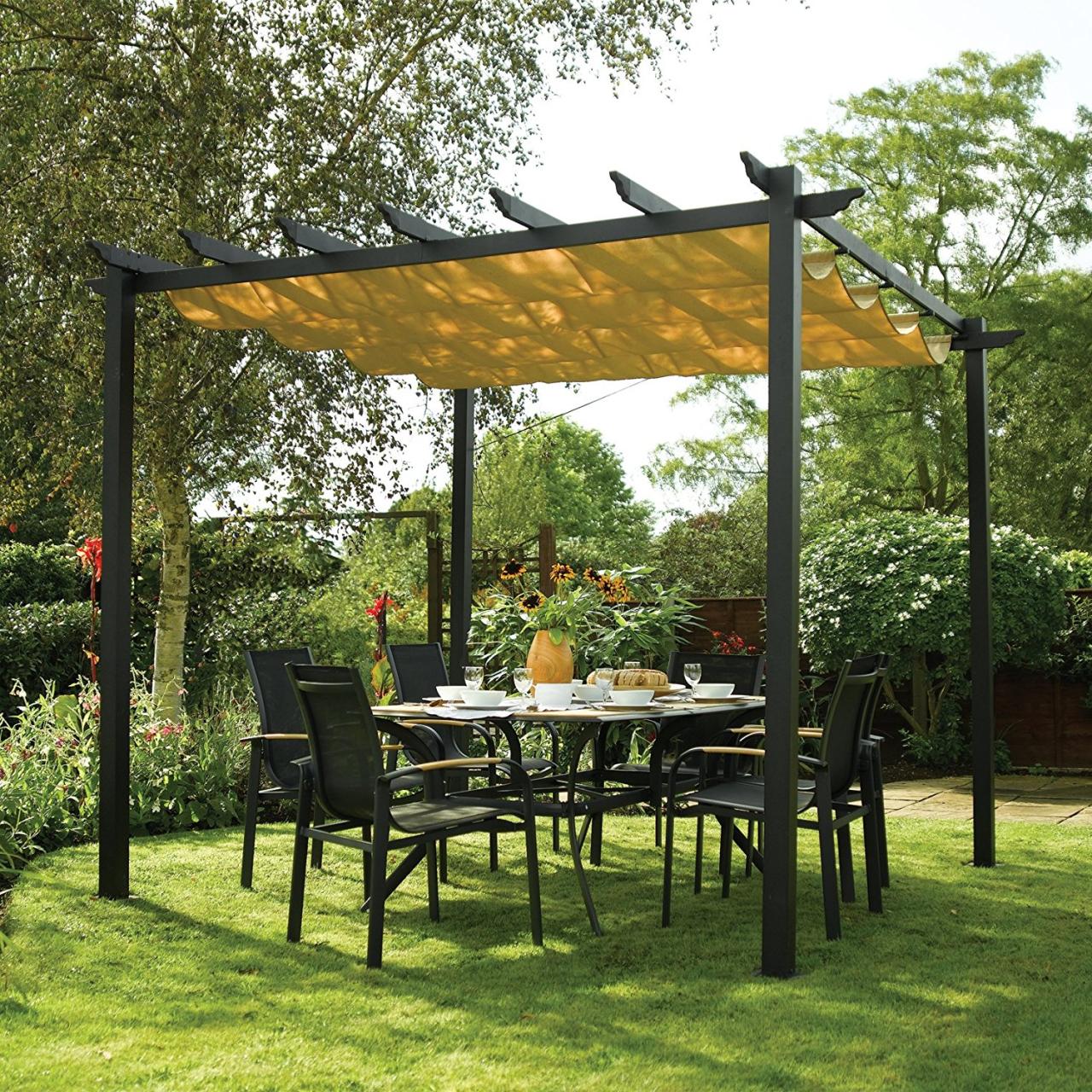
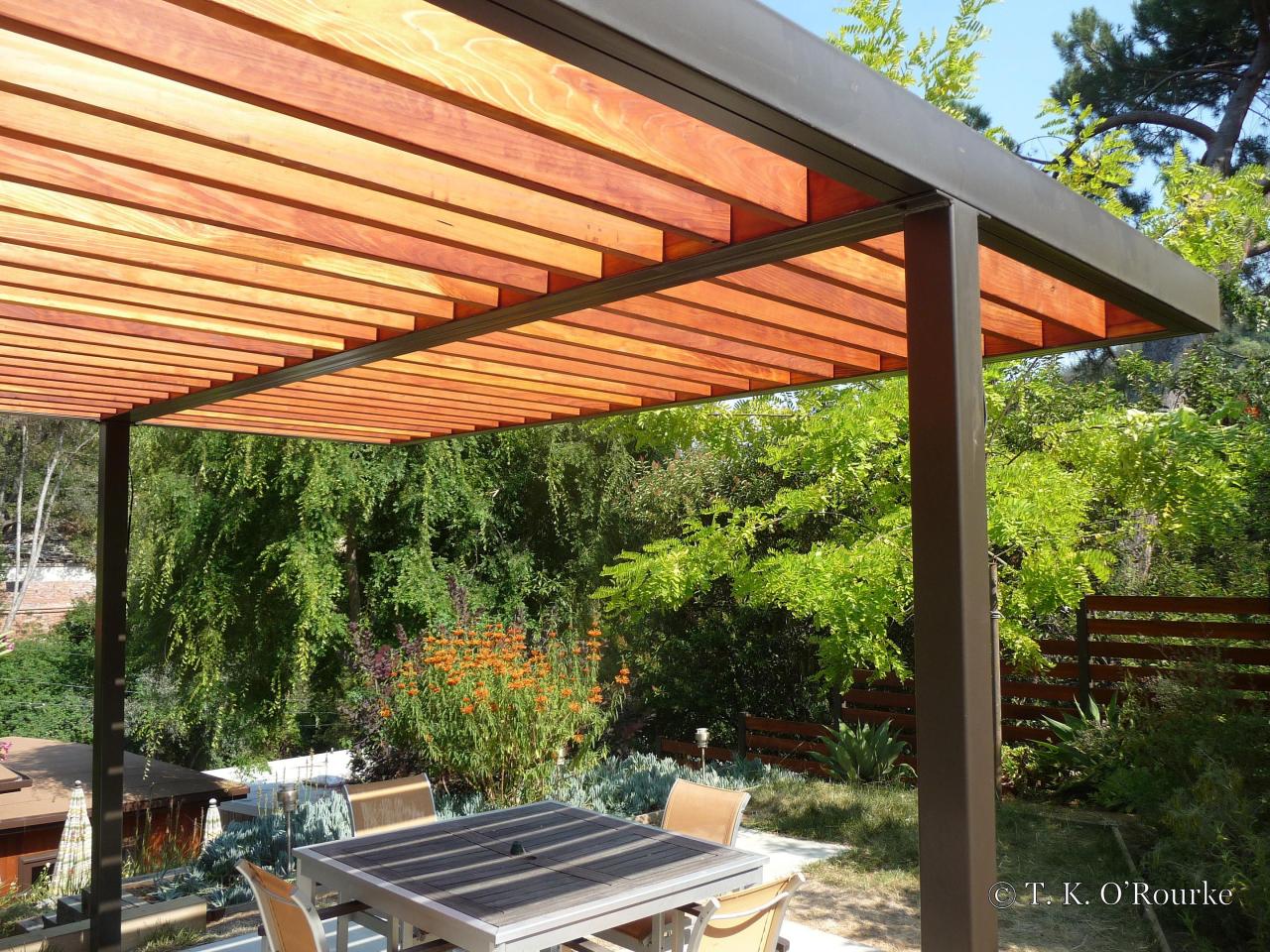
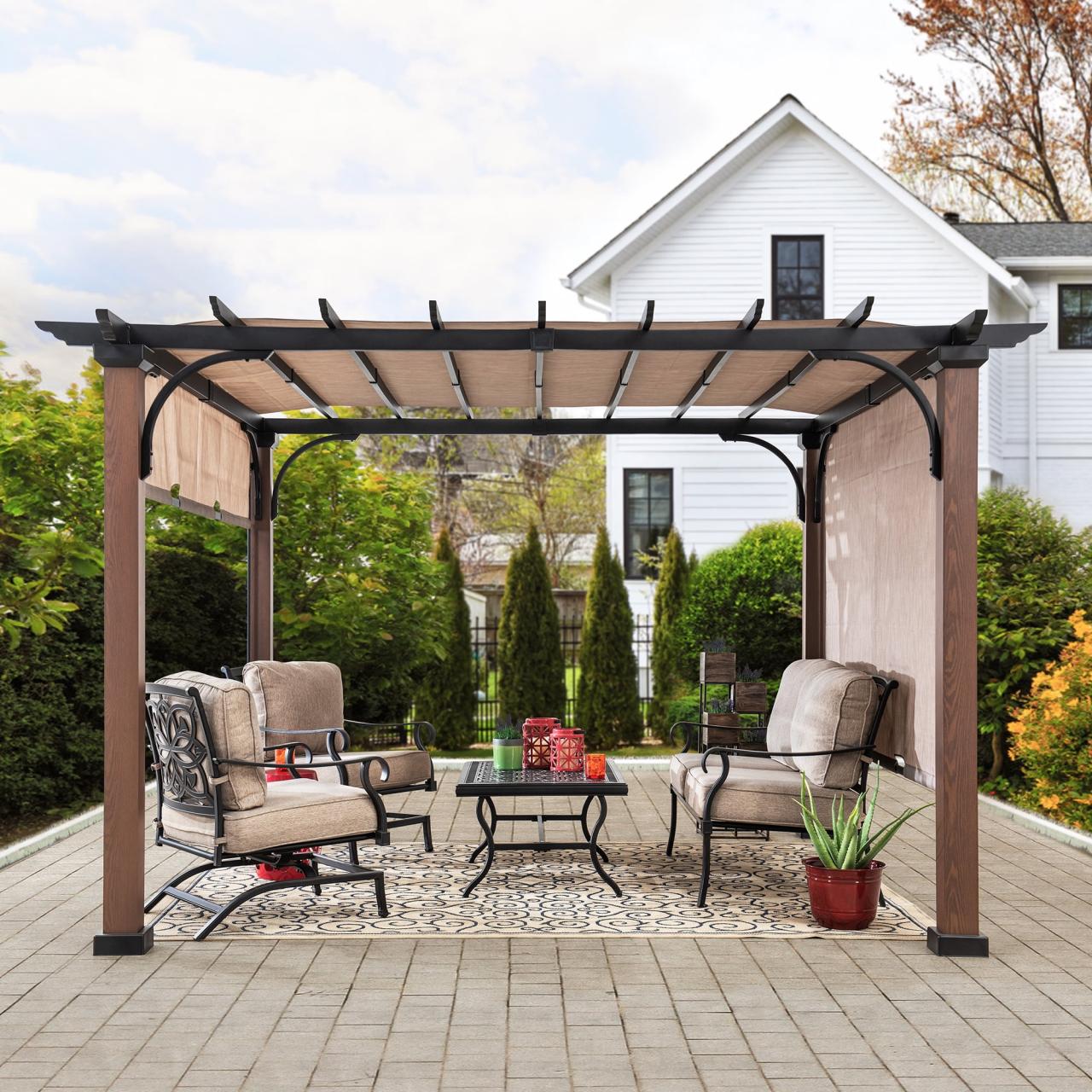

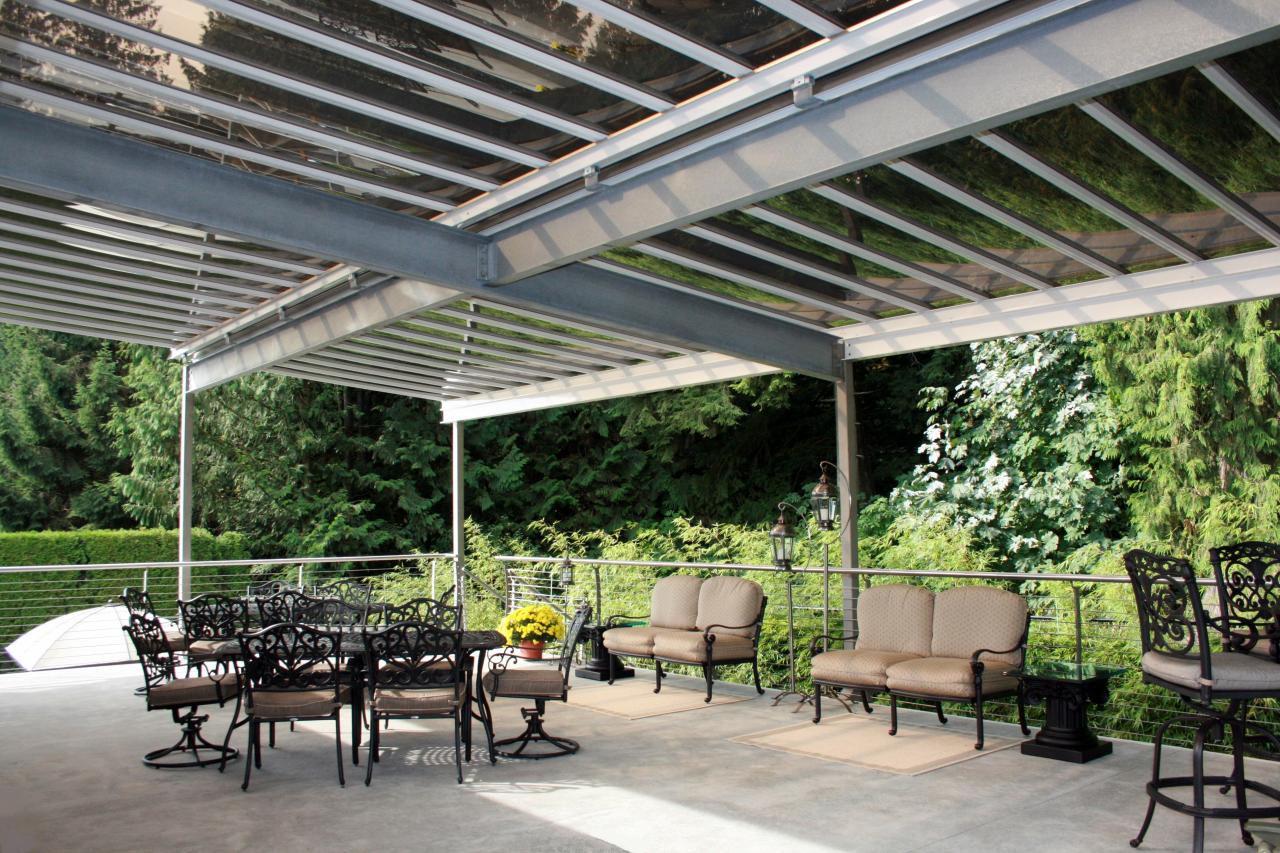
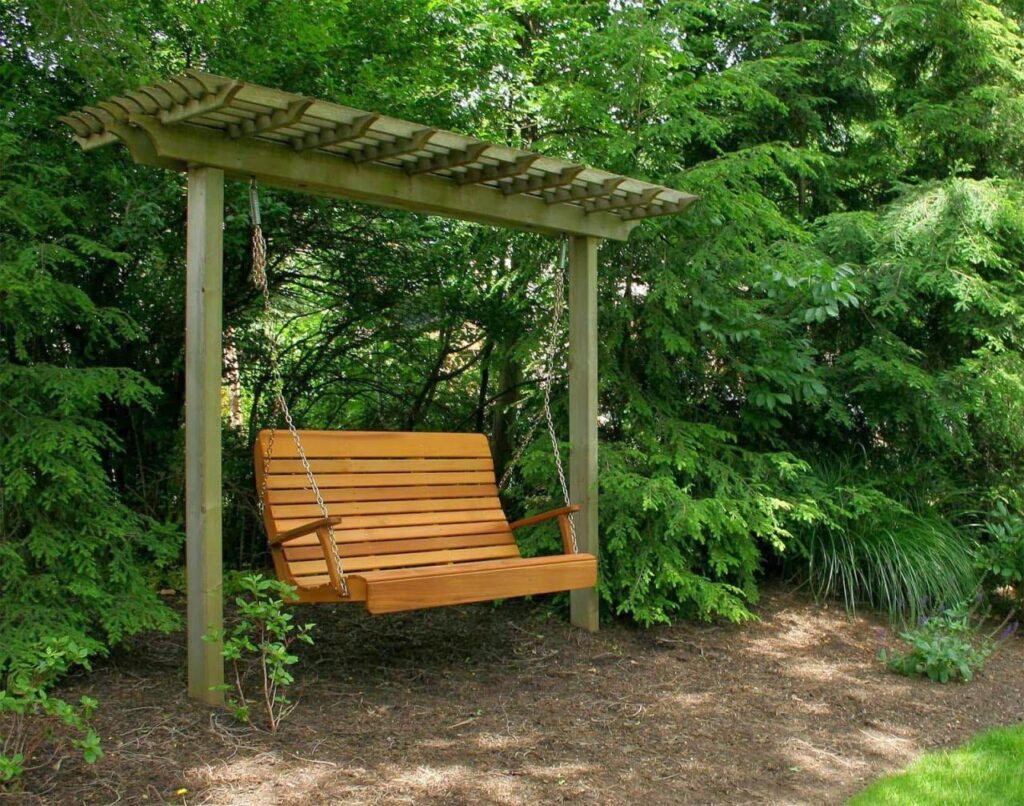

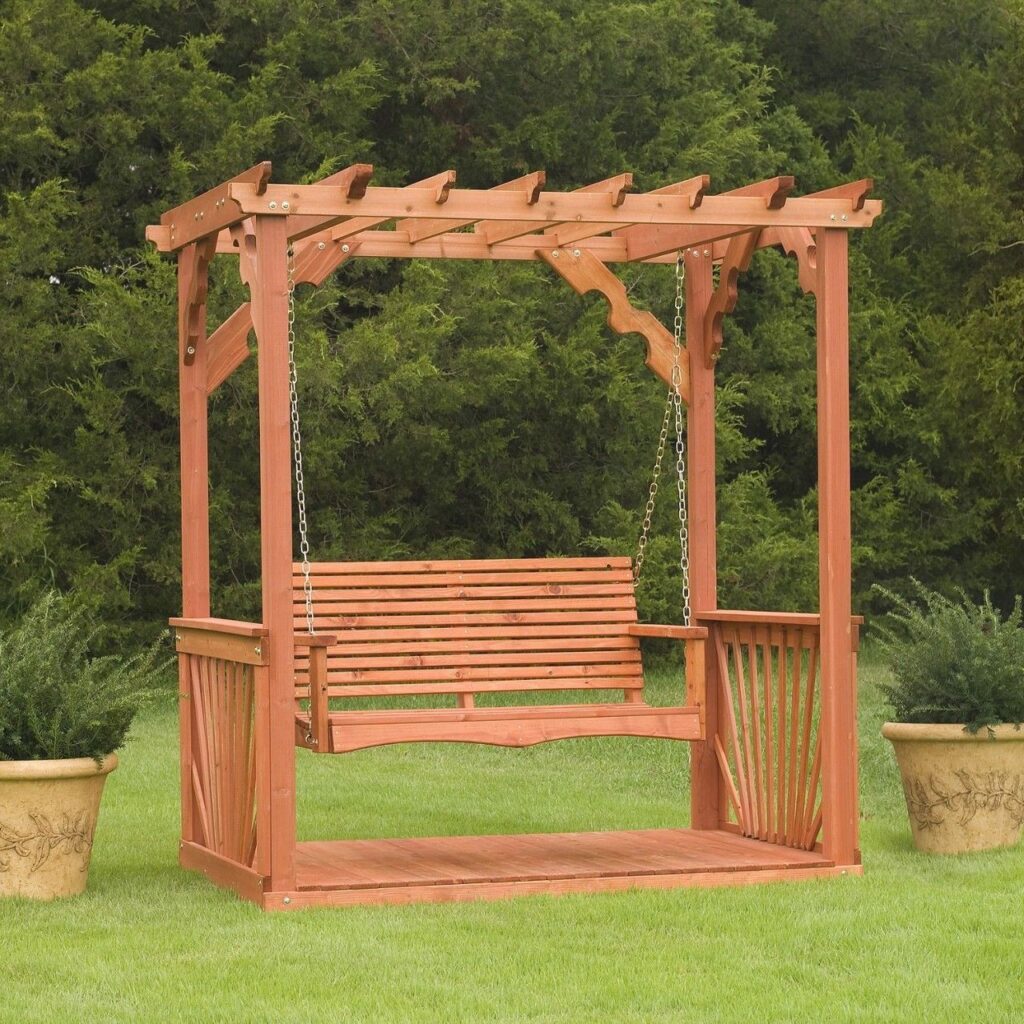

4 thoughts on “Metal Pergolas: A Guide to Stylish Outdoor Living”